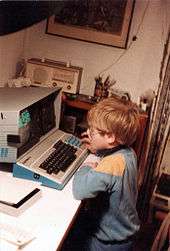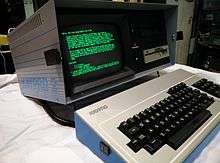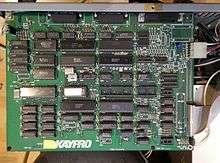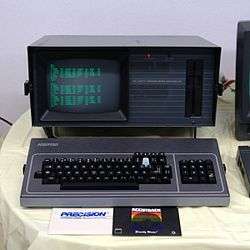Kaypro
|
| |
| Corporation | |
| Industry | Computer hardware |
| Founded | 1981 |
| Defunct | 2001 |
| Headquarters | San Diego, California |
Key people | Andrew Kay |
| Products | Computers |
Kaypro Corporation, commonly called Kaypro, was an American home/personal computer manufacturer of the 1980s. The company was founded by Non-Linear Systems to develop computers to compete with the then-popular Osborne 1 portable microcomputer. Kaypro produced a line of rugged, "luggable" CP/M-based computers sold with an extensive software bundle which supplanted its competitors and quickly became one of the top selling personal computer lines of the early 1980s.
While exceptionally loyal to its original consumer base, Kaypro was slow to adapt to the changing computer market and the advent of IBM PC compatible technology. It faded from the mainstream before the end of the decade and was eventually forced into filing for bankruptcy in 1992.
History
Kaypro began as Non-Linear Systems, a maker of electronic test equipment, founded in 1952 by Andrew Kay, the inventor of the digital voltmeter.
In the 1970s, NLS was an early adopter of microprocessor technology, which enhanced the flexibility of products such as production-line test sets. In 1981, Non-Linear Systems began designing a personal computer, called KayComp, that would compete with the popular Osborne 1 transportable microcomputer. In 1982, Non-Linear Systems organized a daughter company named the Kaypro Corporation and rechristened the computer with the same name.

Despite the numbering, the company's first model used the Roman numeral II—one of the most popular microcomputers at the time was the Apple II. The Kaypro II was designed to be portable like the Osborne. (When battery-powered laptop computers became available, the larger machines came to be called transportable or luggable, rather than portable.) Set in an aluminum case with a keyboard that snapped onto the front covering the CRT, it weighed 29 pounds (13 kilograms) and was equipped with a Zilog Z80 microprocessor, 64 kilobytes of RAM, and two 5¼-inch double-density floppy-disk drives. The built-in keyboard had no Alt key. It ran on Digital Research, Inc.'s CP/M operating system, and sold for about US $1,795 (equivalent to $4,400 in 2015).
The company advertised the Kaypro II as "the $1595 computer that sells for $1595".[1] Although the press mocked its design—one magazine described Kaypro as "producing computers packaged in tin cans"[2]—by mid-1983 the company was selling more than 10,000 units a month, briefly making it the fifth-largest computer maker in the world. The Kaypro II was part of a new generation of consumer-friendly personal computers that were designed to appeal to novice users who wanted to perform basic productivity on a machine that was relatively easy to set up and use. It managed to correct most of the Osborne 1's deficiencies - the screen was larger, the floppy drives stored over twice as much data, the case was more attractive-looking, and it was also much better-built and more reliable. Computers such as the Kaypro II were widely referred to as "appliance" or "turnkey" machines; they offered little in the way of expandability or features that would interest hackers or electronics hobbyists and were mainly characterized by affordable price and a collection of bundled software. The boxy units were so popular that they spawned a network of hobbyist user groups across the United States that provided local support for Kaypro products; the company worked with the user groups and would have a salesman drop by if in the area. Kaypro's success contributed to the eventual failure of the Osborne Computer Corporation and Morrow Designs. A much more rugged seeming, "industrialized" design than competitors such as the Osborne made the Kaypro popular for commercial/industrial applications. Its RS232 port was widely used by service technicians for on-site equipment configuration, control and diagnostics.
The CP/M included with the Kaypro could also read the Xerox 810's single-sided, single-density 86k floppy format. Theoretically, any soft-sector MFM floppy format could be read if the user wrote his own utility program.
Kaypro published and subsidized ProFiles: The Magazine for Kaypro Users, a monthly, 72-page, four-color magazine that went beyond coverage of Kaypro's products to include substantive information on CP/M and MS-DOS; frequent contributors included Ted Chiang, David Gerrold, Robert J. Sawyer, and Ted Silveira.[3]
Another popular magazine that covered Kaypro computers was Micro Cornucopia, published at Bend, Oregon.[4]
Arthur C. Clarke used a Kaypro II to write and collaboratively edit (via modem from Sri Lanka) his 1982 novel 2010: Odyssey Two and the later film adaptation.[5][6][7] A book, The Odyssey File - The Making of 2010, was later released about the collaboration.
Following the success of the Kaypro II, Kaypro moved on to produce a long line of similar computers into the mid-1980s. Exceedingly loyal to its original core group of customers, Kaypro continued using the CP/M operating system long after it had been abandoned by its competitors.
In late 1984, Kaypro introduced its first IBM PC compatible, the Kaypro 16 transportable. While admitting that "it's what our dealers asked for", the company stated that it would continue to produce its older computers.[8] Other PC compatibles were the Kaypro PC, Kaypro 286i (the first 286 IBM PC AT compatible),[9] the Kaypro 386, and the Kaypro 2000 (a rugged aluminum-body battery-powered laptop with a detachable keyboard). The slow start into the IBM clone market would have serious ramifications.
After several turbulent years, with sales dwindling, Kaypro filed for Chapter 11 bankruptcy in March 1990.[10] Despite restructuring, the company was unable to recover and filed for Chapter 7 bankruptcy in June 1992. In 1995, its remaining assets were sold for $2.7 million.[11]
The Kaypro name briefly re-emerged as an online vendor of Microsoft Windows PCs in 1999, but was discontinued in 2001 by its parent company Premio Computers Inc. because of sluggish sales.[12]
Kaypro computers
Hardware


The Kaypro II had a 2.5 MHz Zilog Z80 microprocessor; 64 Kb of RAM; dual, single-sided, 191 kB 5¼ inch floppy disk drives (named A: and B:); and an 80-column, green monochrome, 9" CRT that was praised for its size and clarity.[13]
Early in the Kaypro’s life, there was a legal dispute with the owner of the Bigboard computer who charged that the Kaypro II main circuit board was an unlicensed copy or clone.
The outer case was constructed of painted aluminum. The computer featured a large detachable keyboard unit that covered the screen and disk drives when stowed. The computer could fit into an airline overhead rack.[14] This and other Kaypro computers (except for the Kaypro 2000) ran off regular AC mains power and were not equipped with a battery.
The Kaypro IV and later the Kaypro 4 had two double-sided disks. The Kaypro 4 was released in 1984, usually referred to as Kaypro 4 '84, as opposed to the Kaypro IV released one year earlier and referred to as Kaypro IV '83. The Kaypro IV used different screen addresses than the Kaypro II, meaning software had to be specific to the model.
The Kaypro 10 followed the Kaypro II, and featured a 10 megabyte hard drive (dually partitioned A: and B:) and a single 5¼" floppy drive (C:).The Kaypro 10 is much like the Kaypro II and Kaypro 4 but instead has the 10Mb disk drive. The Kaypro 10 also eliminated the complicated procedures to turn the computer on and off often associated with hard disk technology.[15]
Kaypro later replaced their CP/M machines with the MS-DOS-based Kaypro 16, Kaypro PC and others, as the IBM PC and its clones gained popularity. Kaypro was late to the market, however, and never gained the kind of prominence in the MS-DOS arena that it had enjoyed with CP/M. Instead, Kaypro watched as a new company—Compaq—grabbed its market with the Compaq Portable, an all-in-one portable computer that was similar to Kaypro's own CP/M portables with the exception that it ran MS-DOS and was nearly 100% IBM-compatible. The Compaq was larger and less durable (whereas the Kaypro had a heavy-gauge alumininum case, the Compaq case was plastic, with a thin-gauge aluminum inner shield to reduce radio frequency interference) but had rapidly taken over the market niche.
The 1985 introductions of the Kaypro 286i, the first IBM PC AT clone , and the Kaypro 2000 , one of the first laptop computers (an MS-DOS system with monochrome liquid crystal display and durable aluminum case), did little to change Kaypro's fortunes. Kaypro's failure in the MS-DOS market and other corporate issues helped lead to the company's eventual downfall.
Software
CP/M was the standard operating system for the first generation of Kaypros. The first application software that came with the Kaypro II included a highly unpopular word processor called Select that was quickly dropped in favor of a proto office suite from Perfect Software which included Perfect Writer, Perfect Calc, Perfect Filer, and Perfect Speller, as well as Kaypro's own compiled S-BASIC (which produced executable .com files). Perfect Filer featured non-relational, flat-file databases suitable for merging a contact list with form letters created in Perfect Writer. Perfect Writer itself was initially just a rebranded MINCE and Scribble from Mark of the Unicorn, which was itself a CP/M implementation of the (then) minicomputer Emacs and Scribe using BDS C. Later on MBasic (a variant of Microsoft Basic) and The Word Plus spellchecker were added to the model II suite of software. The Word Plus included a set of utilities that could help solve crossword puzzles or anagrams, insert soft hyphens, alphabetize word lists, and compute word frequencies. Another utility program called Uniform allowed the Kaypro to read disks formatted by Osborne, Xerox, or TRS-80 computers.
The initial bundled applications were soon replaced by the well-known titles WordStar, a word processor, with MailMerge, originally a third-party accessory, for personalised mass mailings (form letters), the SuperCalc spreadsheet, two versions of the Microsoft BASIC interpreter, Kaypro's S-BASIC, a bytecode-compiled BASIC called C-Basic, and the dBase II relational database system.
Using the comma-separated values (CSV) file format (better known at the time as CDF or comma delimited format or comma delimited file), data could be moved between these programs quite easily, which enhanced the utility of the package. The manuals assumed no computer background, the programs were straightforward to use, and thus it was possible to find the CEO of a small company developing the applications needed in-house.
The Kaypro II and later models also came with some games, including versions of old character-based games from earlier days (for example, Star Trek), and a few of which were arcade games re-imagined in ASCII, including CatChum (a Pac-Man-like game), Aliens (a Space Invaders-like game) and Ladder (a Donkey Kong-like game).
All this software if bought separately would have cost more than the entire hardware and software package together. The Kaypro II was a very usable and (at the time) powerful computer for home or office, even though the painted metal case made it look more like a rugged laboratory instrument than an office machine. It enjoyed a reputation for durability.
Later Kaypro CP/M models came with even more software. BYTE in 1984 observed that "Kaypro apparently has tremendous buying and bargaining power", noting that the Kaypro 10 came with both WordStar and Perfect Writer, plus "two spelling checkers, two spreadsheets, two communications programs and three versions of BASIC".[16]
Later MS-DOS Kaypro computers offered a similar software bundle.
Reception
InfoWorld described Kaypro II as "a rugged, functional and practical computer system marketed at a reasonable price." The reviewer called the hardware "first-rate," writing that he had used the computer indoors and outdoors in several countries without fault, and praising the keyboard and screen. Deficiencies included the heavy weight and mediocre documentation.[17]
Jerry Pournelle wrote in BYTE in 1983 that he was able to use a Kaypro II without the documentation. Although he preferred the much more expensive Otrona Attaché, Pournelle called the Kaypro's hardware "impressive" and "rugged," approving of the keyboard layout and "certainly the largest screen you'll ever get in a portable machine."[18] A later review by the magazine described the computer as "best value," citing the rugged hardware design, sharp display, keyboard, documentation, and the extensive bundled software.[19] In 1984 Pournelle stated that "For those without much money, there's no real choice ... you need a Kaypro, which has become both the VW and Chevrolet of the micro industry".[20]
BYTE stated in 1984 that while the Kaypro 10 was "not a technologically innovative machine ... the equipment and power delivered for the price are outstanding", noting that the $2,795 computer "costs less than many stand-alone hard-disk drives". It approved of the "beautiful" monitor as an improvement from the Kaypro II's, and the extensive menus for running software on the hard drive without using the command line. The magazine criticized the "unacceptable" user's guide, and predicted that the large software bundle would be "stupefying" to novice users, but concluded that the computer was an "exceptional value for the money. It should be considered by anyone interested in hard-disk capacity or performance at an excellent price".[16]
Kaypro by model and year
Kaypro's nomenclature was odd, with the numerical designations for their machines having more to do with the capacity of the drives than the order they were produced. Kaypro also released several different models with the same names, perhaps hoping to capitalize on the name recognition of their older machines. As a result, identifying exactly which model a Kaypro is often requires an inspection of their hardware configuration.
All of the computers listed below are of the portable type unless otherwise noted.
- 1982
- Kaycomp I - The first Kaypro was a demonstrator model shown mainly to prospective dealers. It had the same case as future models, but was painted green with two single sided floppy drives that were mounted vertically on opposite sides of the monitor like the Osborne I, its intended competition. A computer virtually identical to the later Kaypro II but labeled "Kaycomp" (not "Kaycomp I") on the side was sold to the public in limited numbers. This version had two vertically mounted drives on the right and a Keytronic keyboard with all-black keys rather than the blue numeric keypad.
- Kaypro II - The first commercially released Kaypro was an immediate success, dominating its competition, the Osborne I microcomputer. The Kaypro II had a 9 inch internal monitor instead of the Osborne's tiny 5 inch display, and single sided floppy drives. A redesigned version of the Kaypro II was released in 1984 that allowed block style graphics, and had half-height drives. This version of the Kaypro II had a version of Space Invaders along with the typical ASCII games.

- 1983
- Kaypro IV - An evolution of the Kaypro II, the Kaypro IV had two DS/DD drives (390 KB) and came with Wordstar in addition to the Perfect Suite of software.
- Kaypro 10 - The Kaypro 10 was one of the earliest computers to come standard with a hard drive. It came with a 10 megabyte internal hard drive and a single DS/DD floppy drive.
- 1984
- Kaypro 4 - The Kaypro 4 was virtually identical to the IV, but featured half-height drives instead of full height drives, a 4 MHz clock speed and had basic graphics capabilities. It also had an internal 300-baud modem.
- Kaypro 2X - The Kaypro 2X was similar to the Kaypro 4, but it lacked the built-in 300 baud modem that was available in the Kaypro 4. Kaypro 2X's were often sold in a bundle with the Wordstar word processing software suite, spreadsheet and database software. The impact printer that was also included in the bundle was labeled as the "Kaypro Printer," but was actually a re-branded Juki 6100 daisywheel printer.
- Kaypro Robie - The Kaypro Robie was the only CP/M based Kaypro to be non-portable. Designed as a desktop computer, it had the same motherboard as the Kaypro 4. It was also equipped with two 2.6 MB high density floppy drives and a 300 Baud modem. The floppy drives were notorious for destroying disks as they literally scraped the media off of the disk substrate. The Robie was jet black, with the drives mounted above the screen, and the front panel angled upward. The Robie did not sell well, but it did make periodic cameo appearances on the ABC television series Moonlighting, as the desktop computer used by Bruce Willis' character David Addison. Due to its black color, the fact that it sat upright and looked like a helmet, and its handle mounted on the top, it was nicknamed "Darth Vader's lunchbox."
- 1985
- Kaypro "New" 2 - A scaled-down Kaypro 2X for the budget buyer, came with minimal software, and did not feature the internal modem.
- Kaypro 4+88 - A dual system computer, the 4+88 was equipped with both an 8088 processor and a Z80, and was capable of running both the MS-DOS and CP/M operating systems. It came with 256 KB of RAM for the MS-DOS operating system that could double as a RAM disk for CP/M.
- Kaypro 16 - Very similar in appearance to the Kaypro 10, the Kaypro's 16's main difference was that it had an 8088 processor and 256 KB of RAM and ran on the MS-DOS operating system instead of CP/M. The Kaypro 16/2e was a "Bundle" for a computer college. It came with Dos 3.3, 2 5.25" 360k Floppy Drives and 768K Ram and bundles software to complete the college course.
- Kaypro 2000 - Kaypro's first and only laptop, it was an MS-DOS machine that ran on heavy lead-acid batteries—the same battery technology used in automobile batteries. Similar in basic appearance to a modern laptop, it featured a detachable keyboard, rugged brushed aluminum casing and a pop-up 3.5 inch floppy drive. In what seems to have been a recurring comparison, it has been called "Darth Vader's laptop."
- Kaypro PC - Late to the PC market, the Kaypro PC was intended as a competitor to the IBM PC-XT desktop machine. Running at a faster clock speed than IBM's machine, it was available with a larger hard drive than that offered by IBM and an extensive software package. It featured the motherboard on a bus card, which, like the Zenith Z-series machines, promised upgradability.
- Kaypro 286i - A 6 MHz 286 desktop, it was the first IBM PC/AT compatible, with dual 1.2 MB floppy drives standard and an extensive software package but no MS-DOS 3.0, which had not yet been released, requiring the user to purchase PC DOS 3.0 from IBM.[21]
- 1986
- Kaypro 1 - The Kaypro 1 was the last CP/M model Kaypro introduced. In most ways, it was simply a Kaypro 2X with a smaller software package. It is distinctive from earlier Kaypro models because of its vertically oriented disk drives.
- 1987
- Kaypro 386 - A 20 MHz 386 desktop, with an extensive software package. It featured the motherboard on a bus card.
References
- ↑ "The $1595 Computer That Sells for $1595.". BYTE (advertisement). January 1984. p. 390. Retrieved 20 January 2015.
- ↑ Dickinson, John (July 1986). "Kaypro 2000". PC. p. 116. Retrieved 9 January 2015.
- ↑ Many issues are archived at https://archive.org/search.php?query=collection%3Akayproprofiles&sort=-publicdate, retrieved 2014-09-10
- ↑ 55 issues are archived at https://archive.org/search.php?query=MicroCornucopia%20AND%20mediatype%3Atexts, retrieved 2014-09-10
- ↑ "Kaypro II computer".
- ↑ "Biography for Arthur C. Clarke".
- ↑ "About Sir Arthur". The Arthur C. Clarke Foundation.
- ↑ Sanger, David E. (1984-11-15). "At Computer Show, Many Retrenching". The New York Times. Retrieved 24 October 2013.
- ↑ Kathy Chin (22 September 2011). "Kaypro introduces first of the PC AT clones". Info World. Tom Casalegno.
- ↑ Brownstein, Mark (March 12, 1990). "Kaypro to Reorganize, Files for Chapter 11". InfoWorld.
- ↑
- US Court of Appeals for the 9th Circuit (2000).Arrow Electronics v. Justus 9955210. Retrieved April. 1, 2006.
- ↑ PC World. (May 22, 2001) http://www.pcworld.com/article/id,50725-page,1/article.html - Accessed: March 15, 2007
- ↑ "Byte Jan 1983".
- ↑ "Byte Jan 1983".
- ↑ "The Kaypro 10; more than just a big screen portable.". www.atarimagazines.com.
- 1 2 McMahon, Steve (May 1984). "The Kaypro 10". BYTE. Vol. 9 no. 5. pp. 206–224. Retrieved 10 September 2016.
- ↑ Derfler, Frank J. (1982-10-18). "Kaypro II—a low-priced, 26-pound portable micro". InfoWorld. p. 59. Retrieved 22 October 2013.
- ↑ Pournelle, Jerry (January 1983). "Burnouts, Bargains, and Two Sleek Portables". BYTE. p. 426. Retrieved 19 October 2013.
- ↑ Fager, Roger; Bohr, John (September 1983). "The Kaypro II". BYTE. p. 212. Retrieved 20 October 2013.
- ↑ Pournelle, Jerry (Aug 1984). "Between Conventions". BYTE. p. 313. Retrieved 24 February 2016.
- ↑ "Kaypro 286i; the first PC AT compatible" by Russ Lockwood, Creative Computing, vol. 11 no. 7, July 1985, p. 25, Retrieved Oct 7, 2009
External links
| Wikimedia Commons has media related to Kaypro. |
- Kaypro II: pictures and details on oldcomputers.net
- Kaypro II on Obsolete Computer Museum
- Kaypro IV & 4
- Kaypro Technical Manual for all models, December, 1984 (5 MB PDF)
- OLD-COMPUTERS.COM all Kaypro models detailed